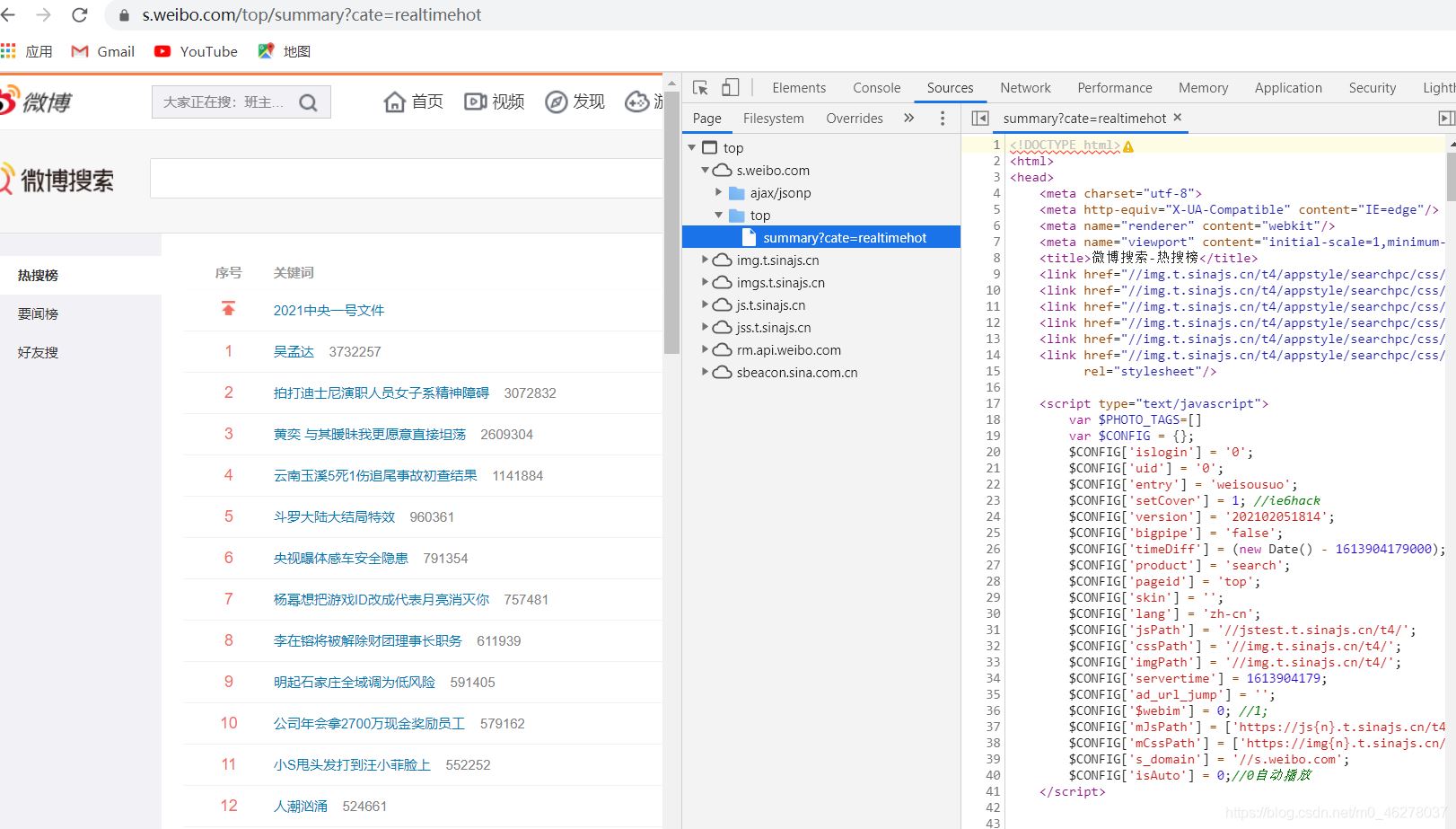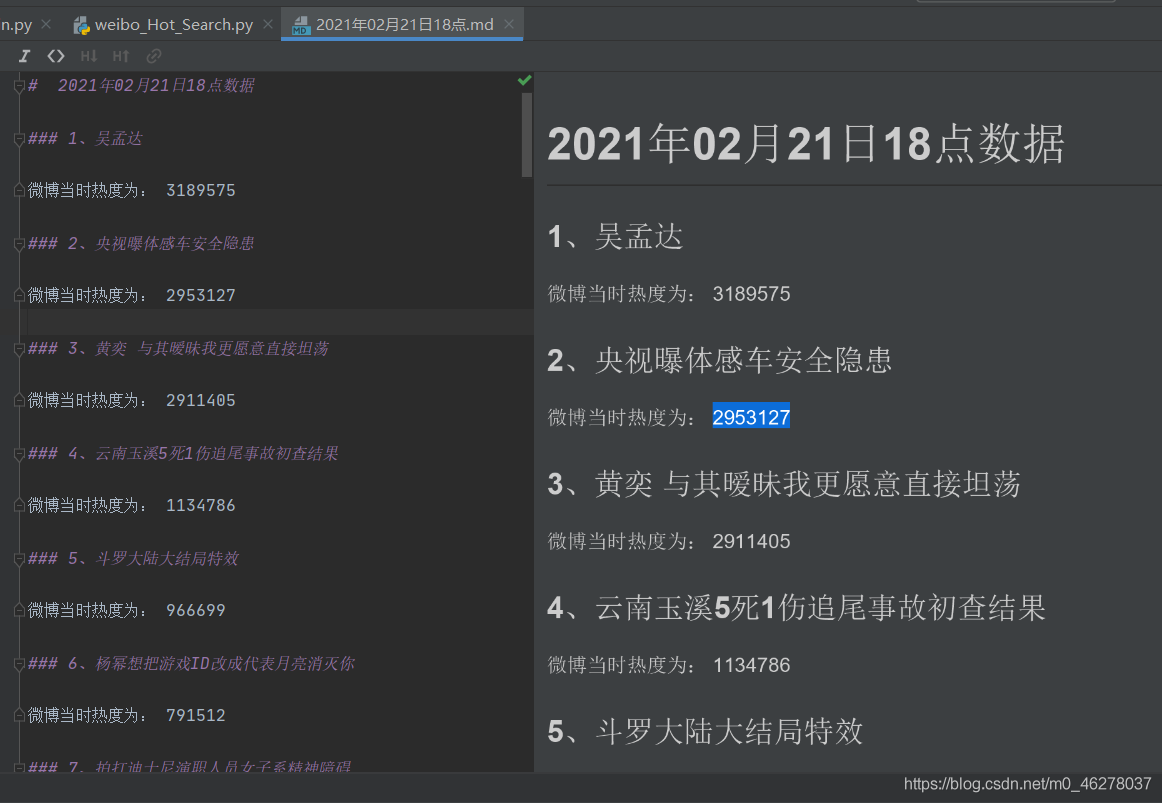什么是爬虫?
网络爬虫(又被称为网页蜘蛛,网络机器人,在FOAF社区中间,更经常的称为网页追逐者),是一种按照一定的规则,自动地抓取万维网信息的程序或者脚本。另外一些不常使用的名字还有蚂蚁、自动索引、模拟程序或者蠕虫。
其实通俗的讲就是通过程序去获取web页面上自己想要的数据,也就是自动抓取数据
爬虫可以做什么?
你可以爬取小姐姐的图片,爬取自己有兴趣的岛国视频,或者其他任何你想要的东西,前提是,你想要的资源必须可以通过浏览器访问的到。
爬虫的本质是什么?
上面关于爬虫可以做什么,定义了一个前提,是浏览器可以访问到的任何资源,特别是对于知晓web请求生命周期的学者来说,爬虫的本质就更简单了。爬虫的本质就是模拟浏览器打开网页,获取网页中我们想要的那部分数据。
微博热搜榜python爬虫,仅供学习交流

源码及注释:
# -*- coding=UTF-8 -*-
#!usr/bin/env python
import os
import time
import requests
from lxml import etree
url = "https://s.weibo.com/top/summary?cate=realtimehot"
headers={
'Host': 's.weibo.com',
'Accept': 'text/html,application/xhtml+xml,application/xml;q=0.9,image/webp,image/apng,*/*;q=0.8,application/signed-exchange;v=b3',
'Accept-Encoding': 'gzip, deflate, br',
'Accept-Language': 'zh-CN,zh;q=0.9',
'Connection': 'keep-alive',
'Referer': 'https://weibo.com/',
'User-Agent': 'Mozilla/5.0 (Windows NT 10.0; Win64; x64) AppleWebKit/537.36 (KHTML, like Gecko) Chrome/78.0.3904.97 Safari/537.36'
}
r = requests.get(url,headers=headers)
print(r.status_code)
html_xpath = etree.HTML(r.text)
data = html_xpath.xpath('//*[@]/table/tbody/tr/td[2]')
num = -1
# # 解决存储路径
# time_path = time.strftime('%Y{y}%m{m}%d{d}',time.localtime()).format(y='年', m='月', d='日')
# time_name = time.strftime('%Y{y}%m{m}%d{d}%H{h}',time.localtime()).format(y='年', m='月', d='日',h='点')
# root = "./" + time_path + "/"
# path = root + time_name + '.md'
# if not os.path.exists(root):
# os.mkdir(root)
# 解决存储路径
time_path = time.strftime('%Y{y}%m{m}%d{d}',time.localtime()).format(y='年', m='月', d='日')
time_name = time.strftime('%Y{y}%m{m}%d{d}%H{h}',time.localtime()).format(y='年', m='月', d='日',h='点')
year_path = time.strftime('%Y{y}',time.localtime()).format(y='年')
month_path = time.strftime('%m{m}',time.localtime()).format(m='月')
day_month = time.strftime('%d{d}',time.localtime()).format(d='日')
all_path = "./" + year_path + '/'+ month_path + '/' + day_month
if not os.path.exists(all_path):
# 创建多层路径
os.makedirs(all_path)
# 最终文件存储位置
root = all_path + "/"
path = root + time_name + '.md'
print(path)
# 文件头部信息
with open(path,'a') as f:
f.write('{} {}\n\n'.format('# ',time_name+'数据'))
f.close()
for tr in (data):
title = tr.xpath('./a/text()')
hot_score = tr.xpath('./span/text()')
num += 1
# 过滤第 0 条
if num == 0:
pass
else:
with open(path,'a') as f:
f.write('{} {}、{}\n\n'.format('###',num,title[0]))
f.write('{} {}\n\n'.format('微博当时热度为:',hot_score[0]))
f.close()
print(num,title[0],'微博此时的热度为:',hot_score[0])
运行:
运行结束后会在当前文件夹下生成以时间命名的文件夹,并且会生成以具体小时为单位的具体时间命名的 Markdown 文件,如下:

查看:

jsjbwy




